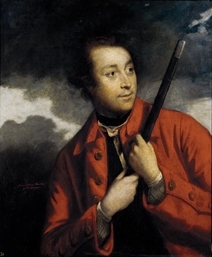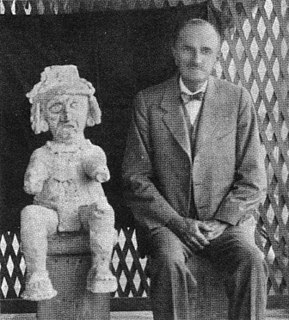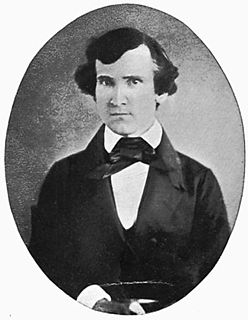
The Siege of Yorktown, also known as the Battle of Yorktown, the Surrender at Yorktown, or the German Battle, ending on October 19, 1781, at Yorktown, Virginia, was a decisive victory by a combined force of the American Continental Army troops led by General George Washington and Gilbert du Motier, Marquis de Lafayette and French Army troops led by Comte de Rochambeau over a British army commanded by British peer and Lieutenant General Charles Cornwallis. The culmination of the Yorktown campaign, the siege proved to be the last major land battle of the American Revolutionary War in the North American region, as the surrender by Cornwallis, and the capture of both him and his army, prompted the British government to negotiate an end to the conflict.

Sir John Barrow, 1st Baronet, was an English geographer, linguist, writer and civil servant best known for term as the Second Secretary to the Admiralty from 1804 until 1845.

Nathanael Greene was a major general of the Continental Army in the American Revolutionary War. He emerged from the war with a reputation as General George Washington's most talented and dependable officer, and is known for his successful command in the southern theater of the war.

General James Inglis Hamilton was a Scottish soldier. He enlisted in the British Army in 1755 and commanded several regiments. He was the only colonel of the 113th Regiment of Foot. During the Seven Years' War (1756–1763), Hamilton fought in the Siege of Fort St Philip, the Raid on St Malo, and the Capture of Belle Île.

François Joseph Paul, Comte de Grasse, Marquis of Grasse-Tilly SMOM was a career French officer who achieved the rank of admiral. He is best known for his command of the French fleet at the Battle of the Chesapeake in 1781 in the last year of the American Revolutionary War. It led directly to the British surrender at Yorktown and helped gain the rebels' victory.

Thomas William Francis Gann was a medical doctor by profession, but is best remembered for his work as an amateur archaeologist exploring ruins of the Maya civilization.

Thomas Pennant was a Welsh naturalist, traveller, writer and antiquarian. He was born and lived his whole life at his family estate, Downing Hall near Whitford, Flintshire, in Wales.

John Dickinson, a Founding Father of the United States, was a solicitor and politician from Philadelphia, Pennsylvania, and Wilmington, Delaware, known as the "Penman of the Revolution" for his twelve Letters from a Farmer in Pennsylvania, published individually in 1767 and 1768. As a member of the First Continental Congress, where he was a signee to the Continental Association, Dickinson drafted most of the 1774 Petition to the King, and then, as a member of the Second Continental Congress, wrote the 1775 Olive Branch Petition. When these two attempts to negotiate with King George III of Great Britain failed, Dickinson reworked Thomas Jefferson's language and wrote the final draft of the 1775 Declaration of the Causes and Necessity of Taking Up Arms. When Congress then decided to seek independence from Great Britain, Dickinson served on the committee that wrote the Model Treaty, and then wrote the first draft of the 1776–1777 Articles of Confederation and Perpetual Union.

Sir Banastre Tarleton, 1st Baronet, GCB was a British soldier and politician. Tarleton was eventually ranked as a general years after his service in the colonies during the American Revolutionary War, and afterwards did not lead troops into battle.

John Kirk Townsend was an American naturalist, ornithologist and collector.

Town & Country, formerly the Home Journal and The National Press, is a monthly American lifestyle magazine. It is the oldest continually published general interest magazine in the United States.
The genre of travel literature encompasses outdoor literature, guide books, nature writing, and travel memoirs.

Jonathan Carver was a Captain in a Massachusetts Colonial unit, explorer and writer. After his exploration of the northern Mississippi valley and western Great Lakes region, he published a widely read account of his expedition, Travels through America in the Years 1766, 1767, and 1768 (1778).

Dumas Malone was an American historian, biographer, and editor noted for his six-volume biography on Thomas Jefferson, Jefferson and His Time, for which he received the 1975 Pulitzer Prize for history and his co-editorship of the twenty-volume Dictionary of American Biography. In 1983 he was awarded the Presidential Medal of Freedom.
Lieutenant Colonel John Enys was a British Army officer who served during the American Revolution.
Thomas Carleton was an Irish-born British Army officer who was promoted to Colonel during the American Revolutionary War after relieving the siege of Quebec in 1776. After the war, he was appointed as Lieutenant-Governor of New Brunswick, and supervised the resettlement of Loyalists from the United States in the province. He held this position until his death.

Pennsylvania was the site of key events and places related to the American Revolution. The state, and especially the city of Philadelphia, played a critical role in the American Revolution.

François Jean de Beauvoir, Marquis de Chastellux, was a military officer who served during the War of American Independence as a major general in the French expeditionary forces led by general Comte de Rochambeau. Being on general Rochambeau's staff for the duration of the war, Chastellux acted as the principal liaison officer between the French commander in chief and George Washington. However the Chevalier de Chastellux was also widely recognized, at the time of his campaigns in America, as a highly talented man of letters and a member of the Académie française
Events from the year 1781 in the United States. This year marked the beginning of government under the Articles of Confederation as well as the surrender of British armed forces in the American Revolution.
The Anson County Regiment was authorized on September 9, 1775 by the Third North Carolina Provincial Congress. The regiment was engaged in battles and skirmishes against the British and Cherokee during the American Revolution in North Carolina, South Carolina and Georgia between 1776 and 1781. It was active until the end of the war.














